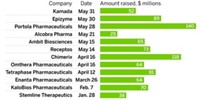Advertisement
Grab your lab coat. Let's get started
Welcome!
Welcome!
Create an account below to get 6 C&EN articles per month, receive newsletters and more - all free.
It seems this is your first time logging in online. Please enter the following information to continue.
As an ACS member you automatically get access to this site. All we need is few more details to create your reading experience.
Not you? Sign in with a different account.
Not you? Sign in with a different account.
ERROR 1
ERROR 1
ERROR 2
ERROR 2
ERROR 2
ERROR 2
ERROR 2
Password and Confirm password must match.
If you have an ACS member number, please enter it here so we can link this account to your membership. (optional)
ERROR 2
ACS values your privacy. By submitting your information, you are gaining access to C&EN and subscribing to our weekly newsletter. We use the information you provide to make your reading experience better, and we will never sell your data to third party members.
Business
Optimism Grows For Biotech
BIO Conference: Economic environment for biotech improves, but challenges persist
by Lisa M. Jarvis
May 10, 2010
| A version of this story appeared in
Volume 88, Issue 19

Biotech executives who flocked to Chicago last week for the Biotechnology Industry Organization’s (BIO’s) annual convention came with a degree of optimism that the industry has turned a corner after a tough 2009.
At last year’s meeting, the industry found itself in a “perfect storm” of economic, political, and scientific challenge, BIO CEO James C. Greenwood told attendees. Companies were finding it difficult, if not impossible, to raise money, and managers were worried about the direction health care reform would take, particularly regarding the impact of legislation on generic biologics.
Today, the industry is “far more optimistic,” G. Steven Burrill, CEO of investment firm Burrill & Co., told a packed auditorium. Patented biotech drugs were given 12 years of marketing exclusivity in the health care bill, and biotech stocks have rebounded.
Money still isn’t flowing freely, but the capital markets have opened up. Ten initial public stock offerings have succeeded since last year’s BIO meeting, Burrill noted, and U.S. biotechs raised a record $48 billion from venture capital, public market, and partnering deals.
Adding to the positive news, a report from Ernst & Young says the biotech industry turned a profit for the first time ever in 2009.
But the good news comes with caveats. The record levels of funds that have been raised often came through deals with less than favorable terms for small firms. And although the industry turned a profit, it wasn’t because of more robust sales. Rather, biotech companies pared back R&D out of fear of not being able to raise more cash.
The Ernst & Young report found that two-thirds of U.S. biotechs and nearly as many European firms reduced spending on research. Deviating from previous trends, U.S. biotech revenues grew 10% last year, but overall R&D spending was down by 13%. “As long as we’ve been tracking the industry, the R&D growth rate has tracked revenue growth,” said Glen T. Giovannetti, Ernst & Young’s global biotechnology leader.
The question now is what impact trimmed R&D budgets will have on the new product pipeline in the coming years. “How much of this is cutting not just fat, but muscle?” Giovannetti asks.
At the earliest stages of research, cash from venture funds is still tight, forcing biotech companies to look to alternative sources of financing. The National Cancer Institute saw applications for its Small Business Innovation Research program, which provides entrepreneurs with early-stage funding, jump by roughly 80% between 2008 and 2009. And this year’s SBIR applications look nearly as robust.
“Companies who never would have looked at SBIR in the past because they would have raised money in the venture world are looking at us now,” said Michael Weingarten, director of the SBIR development center.
Indeed, the BIO meeting itself reflected the continued money worries: Attendance was up slightly from last year to roughly 15,000, but the conference has shrunk considerably from the crush of 22,000 attendees who came in 2007.



Join the conversation
Contact the reporter
Submit a Letter to the Editor for publication
Engage with us on Twitter